"Through the unknown, remembered gate . . . ."
A differently remembered gate —
"Blackboard Jungle," 1955 —
"Through the unknown, remembered gate . . . ."
A differently remembered gate —
Tom McCarthy today on a new novel about von Neumann at Los Alamos:
|
"Beyond its mid-20th-century viewfinder, though, it quickly becomes clear that what The Maniac is really trying to get a lock on is our current age of digital-informational mastery and subjection." "Amid — or, more aptly, beneath — the panoply of brilliant men in The Maniac , women function as bit players. At Los Alamos they’re even called 'computers,' since they carry out the secondary, workaday calculations that are then fed upward for male geniuses to work their magic on. But does von Neumann really deserve the title 'Father of Computers,' granted him here by his first wife, Mariette Kovesi? Doesn’t Ada Lovelace have a prior claim as their mother?" |



* See his post published at 10:00 pm on Monday 27 February 2023.
His categories and tags: Categories — Argentina Heraldry History Monarchy
Tags — Argentina, Chile, History, Latin America, Monarchy, Peru.

"The child is father of the man." — Wordsworth
"Suck any sense from that who can." — Hopkins
Illustration —
An image from "Blackboard Jungle," 1955 —
"Through the unknown, remembered gate . . . ."
From a news article featured on the American Mathematical Society
home page today —
A joint Vietnam-USA mathematical meeting in Vietnam on
June 10-13, 2019:
This journal on June 12, 2019:
Wednesday, June 12, 2019
|
See also the Twentieth of May, 2008 —
"The novel has a parallel narrative that eventually
converges with the main story."
— Wikipedia on a book by Foer's novelist brother
Public Squares
An image from the online New York Times
on the date, July 6,
of the above Atlantic article —
An image from "Blackboard Jungle," 1955 —
"Through the unknown, remembered gate . . . ."
An image from the online New York Times today —
Blackboard Jungle , 1955 —
"Through the unknown, remembered gate . . . ."
For the Church of Synchronology
From the literary journal ELH , Winter 1973 —
See as well …
"The explosion panicked parkgoers and could be heard nearby
at the Orthodox Fifth Avenue Synagogue, where the funeral for
Nobel laureate and Holocaust survivor Elie Wiesel was underway.
Police said they do not think the blast was targeting the funeral."
— Justin Jouvenal in The Washington Post , 7:01 PM ET
on July 3, 2016
Also, from Mark Helprin's In Sunlight and in Shadow ,
a passage linked to here on August 30, 2013 —

“Gates said his foundation is an advocate for the Common Core State Standards
that are part of the national curriculum and focus on mathematics and language
arts. He said learning ‘needs to be on the edge’ where it is challenging but not
too challenging, and that students receive the basics through Common Core.
‘It’s great to teach other things, but you need that foundation,’ he said.”
— T. S. Last in the Albuquerque Journal , 12:05 AM Tuesday, July 1, 2014
See also the previous post (Core Mathematics: Arrays) and, elsewhere
in this journal,
“Eight is a Gate.” — Mnemonic rhyme:
Today's Harvard Crimson—
Students Discuss Mental Health
In an effort to break the silence on an often-stigmatized topic,
members of the Harvard community gathered to share
experiences with mental illness through spoken word,
interpretive dance, and candid conversations at Friday night’s
second-annual “Words on the Mind” open mic night.
Related material from this journal on Friday—
The Hallowed Crucible—
Some related symbolism (headings added Oct. 7)—
|
Words:
Applied Mathematics |
The Mind:
Pure Mathematics |
Today's (Sunday, Oct. 7, 2012) Google Doodle for Bohr's birthday—

Review (See also Faust in Copenhagen in this journal)—
» more
The Hallowed Crucible—
Some related symbolism—
|
Applied Mathematics |
Pure Mathematics |
See also Stallion Gate (a novel) in this journal.
For some related nonfiction, see interviews with
Los Alamos physicist Robert F. Christy, who died
at 96 on Wednesday, October 3, 2012.
A meditation suggested by the April 20 post Complex Reflection
and by the life and April 20 death of a scientist who worked
at Los Alamos (home of the Monte Carlo method) and at
the Santa Fe Institute (home of complexity theory).

A search for 286 in this journal yields "Yet Another Cartoon Graveyard."
That June 1, 2008, post linked to poem 286 in a 1919 anthology.
Here is that poem, together with poem 823.
Together, these poems may be regarded as a meditation on
Simone Weil and her brother André Weil or,
more abstractly, on Love and Death.
Happy birthday to Al Pacino.
"When shall we three meet again?"

Left to right— John von Neumann, Richard Feynman, Stanislaw Ulam
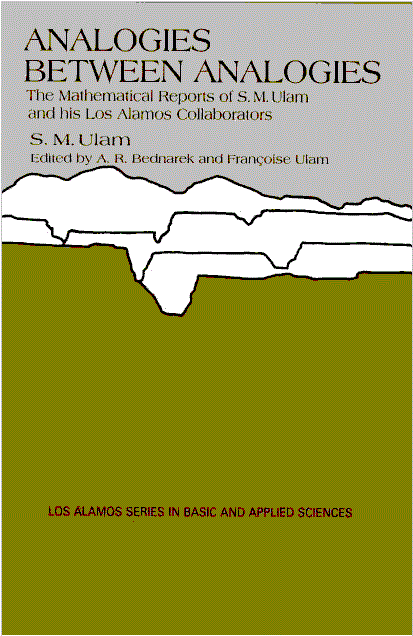
The source of the above book's title, "Analogies between Analogies,"
was misattributed in a weblog post linked to here on March 4th, 2012.
It occurs in a quote due not to Stanislaw Ulam but to Stefan Banach—

Ulam was Jewish. Banach was not.
From a webpage on Banach—
"On 3 April 1892, he was baptized in the Roman Catholic
Parish of St. Nicholas in Krakow."
See also…
(At Los Alamos, Ulam developed the Monte Carlo method.)
(Continued from previous posts)

Detail from a Washington Post page today (below)…
In related news…
The Hallowed Crucible
"After all the pretty contrast of life and death
Proves that these opposite things partake of one,
At least that was the theory…."
— Wallace Stevens, "Connoisseur of Chaos"
The New York Times today
on architect Charles Gwathmey,
who died Monday:
"Mr. Gwathmey's Astor Place
condominium tower drew
criticism from those who
said it was insufficiently
deferential to its
surroundings."
Astor Place tower
(click to enlarge):
Surroundings:
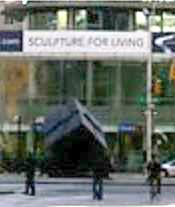
The above sculpture,
popularly known as
The Borg Cube,
appeared here on
Saturday:
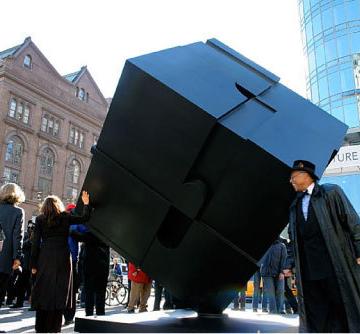
The Borg Cube, with
Cooper Union at left
For deferential remarks, see
Annals of Collective Consciousness.
See also the link
from noon today to
Nobel Prize Day, 2006,
and the link there to
J. G. Ballard on modernism.
"So, there is one place
where modernism triumphs.
As in the cases of the pyramids
and the Taj Mahal, the Siegfried line
and the Atlantic wall, death always
calls on the very best architects."
— J. G. Ballard,
"A Handful of Dust"
The Astor Place sculpture, near Cooper Union, is also known as The Borg Cube:

The Borg Cube, with
Cooper Union at left
Wikipedia on The Borg Queen:
Possible Borg-Queen candidates:
Helen Mirren, who appeared in this journal on the date of Rosenthal's death (see Monumental Anniversary), and Julie Taymor, who recently directed Mirren as Prospera in a feminist version of "The Tempest."
Both Mirren and Taymor would appreciate the work of Anita Borg, who pioneered the role of women in computer science. "Her colleagues mourned Borg's passing, even as they stressed how crucial she was in creating a kind of collective consciousness for women working in the heavily male-dominated field of computer technology." —Salon.com obituary
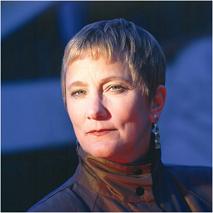
Anita Borg
Borg died on Sunday, April 6, 2003. See The New York Times Magazine for that date in Art Wars: Geometry as Conceptual Art—

I would award the Borg-Queen Tony to Taymor, who seems to have a firmer grasp of technology than Mirren.
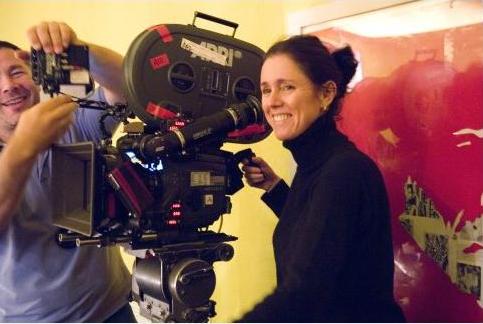
See Language Game,
Wittgenstein's birthday, 2009.
Death of a Holy Man
Part I: An American Religion
Hiroshima Mayor Says
US Worships Nukes
“HIROSHIMA — Hiroshima Mayor Tadatoshi Akiba warned that the world is moving toward war and accused Washington of ‘worshipping’ nuclear weapons during Wednesday’s ceremony marking the 58th anniversary of the atomic bombing of the city….
… the Hiroshima mayor blamed the United States for making the world a more uncertain place through its policy of undermining the Treaty on the Non-Proliferation of Nuclear Weapons.
‘A world without nuclear weapons and war that the victims of the atomic bomb have long sought for is slipping into the shadows of growing black clouds that could turn into mushroom clouds at any moment,’ Akiba said. ‘The chief cause of this is the United States’ nuclear policy which, by openly declaring the possibility of a pre-emptive nuclear strike and by starting research into small ‘useable’ nuclear weapons, appears to worship nuclear weapons as God.’ “
— Mainichi Shimbun, Aug. 6, 2003
Part II: Holy Men and
Sons of Bitches
“I am become Death, the Destroyer of Worlds.”
— Dr. J. Robert Oppenheimer,
Director of Los Alamos
John Steinbeck describing Cannery Row in Monterey:
“Its inhabitants are, as the man once said, ‘whores, pimps, gamblers, and sons of bitches,’ by which he meant Everybody. Had the man looked through another peephole he might have said, ‘Saints and angels and martyrs and holy men,’ and he would have meant the same thing.”
“Now we are all sons of bitches.”
— Dr. Kenneth Bainbridge,
Director of Trinity Test
Part III: Death of a Holy Man
|
The New York Times, Aug. 10, 2003: Atom-Bomb Physicist Dies at 98 “Henry A. Boorse, a physicist who was one of the original scientists who worked on the Manhattan Project in the development of the atomic bomb, died on July 28 in Houston, where he lived…. Dr. Boorse was a consultant to the United States Atomic Energy Commission from 1946 to 1958 and to the Brookhaven National Laboratory from 1951 to 1955. He and Lloyd Motz wrote a two-volume work, The World of the Atom (1966), and — with Jefferson Hane Weaver — a one-volume book, The Atomic Scientists (1989).” |
From a review of The Atomic Scientists:
“… the authors try to add a personal element that can excite the reader about science.”
For more excitement, see Timequake, by Kurt Vonnegut, Jr.
Rhymes with Puck
Readings for May Day, also known as Beltane.
I. The Playboy of the Western World
II. Beltane
III. A is for Art
Bell/Taine
In 1993, The Mathematical Association of America published Constance Reid’s
THE SEARCH FOR E. T. BELL
also known as John Taine.
This is a biography of Eric Temple Bell, a mathematician and writer on mathematics, who also wrote fiction under the name John Taine.
On page 194, Reid records a question Bell’s son asked as a child. Passing a church and seeing a cross on the steeple, he inquired, “Why is the plus up there?”
For an answer that makes some sort of sense
consider the phrase “A is for Art,” so aptly illustrated by Olivia Newton-John in “Wrestling Pablo Picasso,” then examine the photograph of ballerina Margaret “Puck” Petit on page 195 of Reid’s book. Puck, as the mother of Leslie Caron (see Terpsichore’s Birthday), clearly deserves an A+.
Powered by WordPress